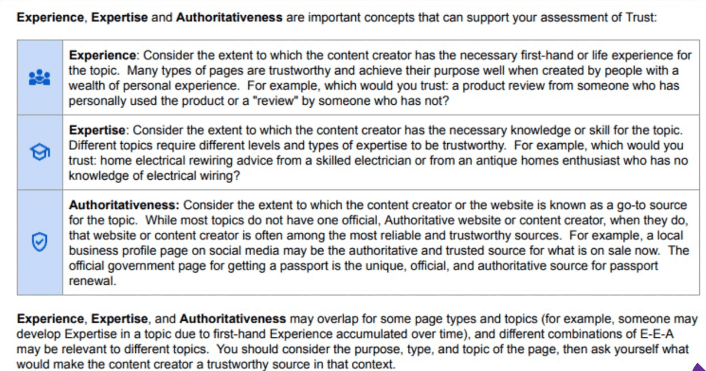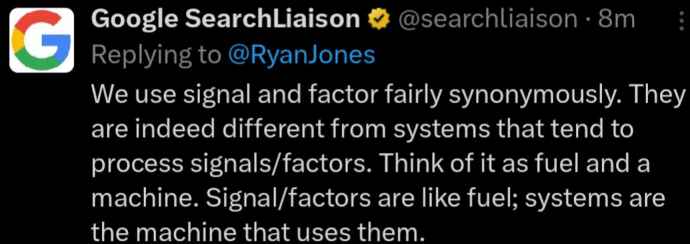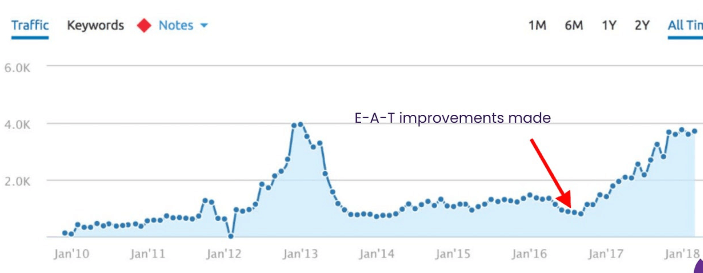If you are interested in SEO, you should read Google’s new starter guide to SEO, as they have changed it significantly. I’d encourage you to look at how often they discuss “topics.” The more I learn about Google’s systems, the more interested I am in understanding Google’s use of topics.
They removed a few things from the guide that could be more beginner SEO discussions, such as schema and breadcrumbs.
The guide emphasizes creating helpful and reliable content aligned with the things described as E-E-A-T in the rater’s guidelines. However, it also tells us we should not focus on E-E-A-T, saying, “Is E-E-A-T a ranking factor? No, it’s not.”
I know that sounds contradictory. Boy, is there confusion over E-E-A-T. Here’s where I stand:
E-E-A-T is described in the quality raters’ guidelines as concepts that can support the rater’s trust assessment.

These concepts are not ranking factors. Wait… let’s pause here. What even is a ranking factor? What is a ranking signal?
Danny Sullivan says that at Google, they essentially consider a signal and a factor the same:

Many of Google’s systems can use a signal or, if you prefer, a factor. One of the most common signals we know as SEOs is links. But Google has confirmed that there are hundreds of signals. This is from 2016:

The systems don’t look for individual signals and add up any E-E-A-T score. They don’t say, “Ah, here’s a doctor, let’s increase the score for this site,” or “There’s wording here that sounds like they are demonstrating experience. Therefore, let’s rank this higher.”
E-E-A-T is an estimate of your legitimacy for providing information on your topics.
No single ranking factor or signal determines e-E-A-T. Instead, it comes from Google’s understanding of all of the signals and information that they have, whether it is in the knowledge graph, signals that come from other sources (like links, mentions, customer reviews, etc.), or likely even real-world signals like perhaps whether people are visiting your business and engaging with it.
You either have the appropriate E-E-A-T to discuss your topics or need to.
You can improve and build upon your E-E-A-T the same way that you would in real life. How do you become known as a topic authority? You do things that cause people to come to you when they want to learn about that topic. You do things that get the press talking. If you’re a local business, you make your presence known by doing good things in your community. If you’re a store in the offline world, the only way you will succeed is to convince people to visit you regularly. And the only way you are going to do that is if you are a store that meets your customers’ needs.
It would help if you were helpful to have E-E-A-T. You need to be known for that as well.
Years ago, we could improve E-E-A-T in meaningful ways that impacted rankings, often with just on-page SEO changes. We could make on-site changes like adding author bios and using SameAs schema to signal to Google’s systems that our content came from a place of expertise. Or we could suggest removing or improving content on parts of the site that contradicted scientific consensus and doing more to add authoritative and scientific references. Or, in some cases, we’d recommend improvements to the About page of a site.
And sometimes, a site would see beautiful improvements.

These things I’ve mentioned are all good to do. But, increasingly, Google’s systems are improving at taking the myriad of signals they can use and learning to approximate what is legitimate best.
Today, a few on-page E-E-A-T tweaks will not likely help you significantly improve. But, genuinely becoming known for being a go-to source on your topics can do all sorts of things to send signals to Google that an audience of people finds your content helpful. As the systems learn whether searchers are satisfied with your site, you should see more and more improvement.
The glaring issue here is spam in Google’s search results. If you have sites ranking above you that are only there because they’ve figured out how to manipulate rankings and not because they genuinely are the topic experts with helpful content in your industry, you may find things improve soon. Once again this week, Danny Sullivan told us that significant change is coming to deal with the spam in Google’s search results.